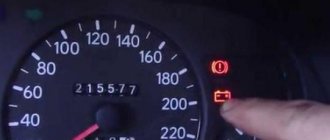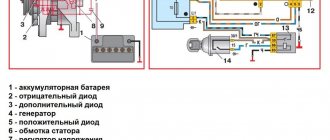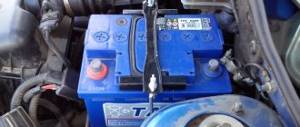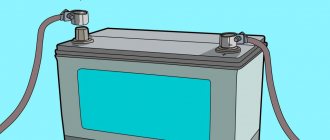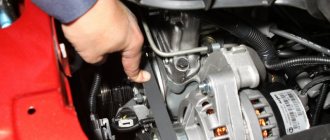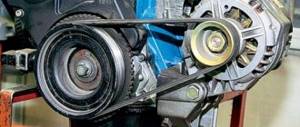How long will the battery last?
It is difficult to determine exactly which route you can travel with a faulty generator. There are too many factors influencing this. You can get the most mileage when driving evenly in a straight line, at above-zero temperatures, with an unloaded car and a new battery. But we all know that “in reality everything is not as it really is”© and there are no ideal conditions.
It is enough to simply determine the time, or in other words: how long will the battery last? It's not that hard to find out.
For most batteries, not only the nominal capacity is written on the case, but also the reserve capacity - RC (Reserve Capacity) , measured in minutes. In other words, this is the amount of time during which the battery will supply the car with enough electricity to operate if the generator is faulty.
Reserve capacity is the amount of time required to discharge the battery with a current of 25 amperes to a voltage of 10.5 volts and a temperature of 25 C°.
And if suddenly, along the way, the generator breaks down, then by opening the hood and reading the RC indicator on the label, we will at least approximately know how much time we have left.
How long will the car travel?
To understand how long a car will travel on a battery without a generator, you need to familiarize yourself with its design features and parameters. In particular, it is worth paying attention to the capacity, which determines the maximum permissible load. For passenger cars it averages 55-75 A/h, and for trucks it is an order of magnitude higher. At the same time, the figure indicated on the label is valid at +25°C and from it you can determine the current level at which the battery will discharge after 20 hours of operation.
When making calculations, you should also remember about parameter errors. As a rule, the values declared by the manufacturer are nominal, while the real ones are 80-110%. For example, with a declared capacity of 55 A/h, the battery will be discharged after 20 hours at a current of 2.75 A (55/20). And, in order to calculate the exact distance, it will be necessary to take into account all the electricity costs that cannot be avoided when operating the car (you should add up the consumption of all appliances and devices that cannot be avoided). In particular, it is difficult to imagine a vehicle that can function without a fuel pump or injector, which consumes up to 5 A of alternating current, the ignition will require another 1-2 A, and the instrument panel will require up to 1 A.
What to do if it breaks?
When faced with such a malfunction on the road, you need to make a decision quickly and correctly. If it’s not far from home or the place of repair, then you can continue driving directly at the expense of the battery.
Important! It is possible to drive a car without a generator, although it is not advisable.
The greatest discharge of the battery occurs when starting the engine, so if the generator is faulty, it is recommended not to turn off the engine unnecessarily, because this will significantly reduce the battery discharge time. When it is still necessary to turn off the engine, try to stop on a hill or slope and start the engine “from the pusher”.
Without a generator, the car will start, but it is unknown whether the car will start after a long trip on the battery alone.
Sometimes you can immediately assess the malfunction and the possibility of repair here and now.
Why might a generator fail?
A car's generator is a fairly reliable unit, but it can also break down while on the road. In this case, the only source of electricity will be the car battery, and its supply will be exhausted.
The most common breakdowns of a car generator include:
- Break or short circuit of the turns of the stator winding, or field winding (located on the rotor). A very serious breakdown, which cannot be corrected on the way.
- Malfunction of the brush assembly, that is, damage to the brushes or their freezing. With such a malfunction, the generator can continue to generate energy, but it will not be enough for full autonomous operation.
- Damage to the rectifier unit. Usually it consists of a burnt-out diode bridge; such a breakdown is not repaired, but the entire rectification unit is replaced.
- Failure of the rotor shaft bearings. The bearing may not only wear out and begin to whistle and grind, which in itself is unpleasant (while the energy supply will continue), but it may simply jam the generator rotor - and this requires mandatory removal of the generator belt, right at the site of the breakdown. Otherwise, the belt itself will fray and burst. The bearing needs to be replaced, the generator rotor needs to be checked.
- Broken wire at output terminal. Although the breakdown can be solved, it is quite dangerous, because the generator continues to supply energy to the broken wire. A piece of wire will simply cause a short circuit and fire.
This is interesting: Do-it-yourself insulation of a car battery
Most breakdowns do not completely disable the generator, and it will still continue to provide the car with at least part of the required voltage. Or these problems can be eliminated if detected in a timely manner. But some malfunctions will not allow the generator to work at all and require complex repairs or even replacement of individual components.
Is it possible to drive without a belt?
Separately, it is worth noting a broken alternator belt as one of the most common malfunctions, and also because it can be corrected yourself right on the road.
Yes, you can drive without an alternator belt, but you can also replace it.
If the alternator belt breaks, it can be replaced with improvised means, but this should only be done in cases where a thorough repair is impossible, but it is necessary to continue a long journey.
The belt substitute must be strong enough; preference should be given to belts made of thick rubber or leather. A regular waist belt works well. You will have to remove the plaque and all metal parts from it, and then sew it with thread, wire or rivet it with something. The belt obtained in this way is quite reliable and can withstand more than tens of kilometers.
You can also knit a kind of belt from rope, thick fabric (for example denim), or even from a tie. This solution will allow you to get to the repair site, but under no circumstances should it be used permanently.
Is it possible to continue driving after the belt breaks?
A broken alternator belt does not mean that the car cannot be driven, but the problem is that the distance you can drive will be short. The batteries will not have enough energy for a long trip, so head to the repair site immediately. If possible, turn off all electrical appliances, lights, audio system, navigation, furnace, air conditioning. Try to turn off and start the car as little as possible - this is an additional load on the battery.
Consequences of driving without an alternator belt
As a rule, driving without an alternator belt does not pose any negative consequences to other engine components and systems. The only thing is that you can completely drain the battery. Also, in some cases, if power steering is provided, the steering wheel may be harder to turn. But in any case, after a break, put everything aside and start installing a new one in order to avoid negative consequences.
It is difficult to give a definite answer to the question of how long a car can drive without an alternator belt. Here, a lot depends on the make of the car, the charge level of the battery and the degree of charge of the battery. In some cases, a car can travel more than half a day, and in others no more than half an hour. But you shouldn’t take risks and experiment; go straight to the place where you can install a new belt that will fit your car.
Install only the drive that is specialized for your vehicle model.
Bosch drive, suitable for many models
Installing a new one does not involve any special difficulties or irreparable consequences and can be done independently or by service station specialists; here the choice is only yours.
How to optimize your work
If the breakdown is not obvious or cannot be fixed with your own hands, and the path to the nearest populated area is not close, then you should adhere to some rules.
It is necessary to minimize all energy costs:
- do not turn on electrical equipment unless absolutely necessary;
- instead of high and low beams, turn on the side lights or hazard lights;
- Accelerate slowly to reduce engine speed;
- coast down the mountain;
- try not to turn off the car so as not to waste energy on starting.
Another correct solution would be to somehow increase the battery's electrical capacity. It is unlikely that you will come across a spare car battery on the road. A “Power Bank” for mobile devices, or a special lithium battery to facilitate engine starting (if available) will be useful.
Important! Wherever the problem occurs, the main thing is to solve it quickly and not panic.
The duration of operation depends both on external influences and on the power source itself. The first include weather conditions, the number of electrical appliances and the current they consume. The same car with the electrical equipment turned on and off will travel different distances.
Here are approximate data on electricity consumption by appliances:
| Consumer | Minimum current, A |
| Signal horn | from 1.5 to 3 |
| Fan | from 3 to 6 |
| Cruise control, headlight range control | from 0.5 to 1 |
| Dimensions | from 1 to 2 |
| High and low beam | from 7 to 15 |
| Rear fog lamp | from 5 to 15 |
| Heating | from 7 to 14 |
| Glass heating | from 4.5 to 9 |
| Bake | from 14 to 30 |
| Radio tape recorder | from 0.5 to 2 |
| Wipers | From 2 to 5 |
| Window lifters, sunroof drive | from 5.5 to 11 |
This is interesting: What is good about the delkor battery?
Here is the approximate electricity consumption of the necessary systems:
| Regular consumer | Required current, A |
| Fuel pump | from 2.5 to 5 |
| Injector | from 2.5 to 5 |
| Ignition | from 1 to 2 |
| Dashboard | from 0.5 to 1 |
| Side and tail lights | about 2 |
| Driving lights | 15 |
| Low beam headlights | 12 |
In total, the electrical energy consumption of car systems when driving is considered equal to 25 amperes , but this figure can be considered minimal and even underestimated. Since under real conditions on the road, consumption will be 30% or even 100% more.
How far can you travel?
To calculate how far a car will travel on a battery without a generator, you need to familiarize yourself with its parameters and design features. The average capacity of passenger vehicles is 55 - 75 A/h, and higher for trucks.
REFERENCE! It is important to remember that in the cold season, more energy will be spent on warming up the engine, and in hot weather, the engine may overheat and the forced cooling fans will waste extra energy.
Also an important factor will be what kind of tires the car costs, whether the windows are open and what kind of terrain the driver is driving on. It is obvious that when driving on gravel with open windows and worn tires, the car will spend more energy than when driving on asphalt.
If possible, avoid uneven spots and bumps where you can slide freely - don’t miss it. Every meter counts if you don't want to push the car manually. Do not try to accelerate and drive through the segment by inertia, turning off the engine, you will not gain anything by doing this, but will only spend more energy on the acceleration itself. Remember that energy is mostly spent accelerating the car and going uphill.
In other words, you can count on 90-110 km. It wouldn’t hurt to call a tow truck to come meet you, because completely discharging the battery in 90% of cases leads to its failure, and you won’t be able to continue your journey after that.
As a result, the average distance that can be driven on a battery without a generator is about 100 kilometers. In the summer, during the daytime, on a straight, good road, you can travel twice as far, and on a winter night, the distance will be reduced to 50, or even 30-40 kilometers.
How many kilometers can a car travel without a generator?
To calculate the distance that a car can travel, you need to know its design and basic parameters. The main indicator from which to base the calculation is capacity; it indicates the permissible load and corresponds to the displacement of the engine. This number is always indicated on the battery label.
The capacity of a passenger car is from 55-75 Ah, while that of a truck is higher. The sign on the label is +25°C. Using this number, you can determine the current at which the battery will be completely discharged within 20 hours.
The number indicated by the manufacturer is nominal, it ranges from 80 to 110% of it. Let's look at an example. Capacity 55 Ah, battery will be discharged after 20 hours. 55/20=2.75 Ampere. When making calculations, it is necessary to take into account the electricity consumption of the battery. There is a constant load that cannot be avoided. Whereas it is quite possible to turn off the headlights, heated seats, and the tape recorder. It is also necessary to take into account the engine speed. To obtain the correct result, it is necessary to sum up the electricity consumption of all consumers.
How to calculate battery life
As an example, we take a car with an injection engine and a capacity of 60 A*h, the headlights are on, the fan is on, and the season is summer. The total consumption is approximately 15 Amps. Constant consumption – 8 Amperes. The figures appeared taking into account the injection system, which is 4 Amperes; if the carburetor system is taken into account, the figure will drop to 2.5 Amps. Total current - 23 Amperes. Operating time is calculated using the following formula: 60/23=2.6 hours.
At a speed of 90 km/h, the car can travel 234 km on one battery. Attention! This result is purely theoretical. It must be taken into account that electrical energy losses will increase sharply while driving. These calculations are close for a battery in ideal condition, which is fully charged. It should be clear that in the winter season the figures will be lower.
What to do when the question arises: “Should I drive on one battery or not?”
In an emergency, you can count on the car to travel a short distance on battery power alone. But it’s better not to take risks and, if possible, evaluate the road. Don't think you can cover the maximum distance without problems, so find out where the nearest service station is. It’s better to play it safe and think about how you will get out of the situation if you are left alone on an empty road away from people.
When starting calculations, take into account the incomplete charge of the battery and frost. You can measure the battery voltage using a voltmeter. Disconnect the battery. Figures of 12.2 V or less indicate a charge of less than 50%. Electrolyte density is from 1.26 – 1.29 g/cm3. Here, a lower indicator indicates a greater degree of discharge.
To be more confident, you can take a spare battery with you or recharge the one you have. This option, of course, is not suitable for everyone.
